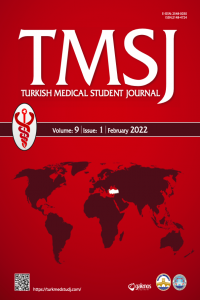AN INVESTIGATION ON THE ANTICANCER EFFECT OF SPIDER WEB IN HUMAN CERVICAL CELL LINE
AN INVESTIGATION ON THE ANTICANCER EFFECT OF SPIDER WEB IN HUMAN CERVICAL CELL LINE
Aims: The aim of this study is to investigate the anti-cancer and anti-proliferative effect of spider web extract, and mitochondrial apoptosis signaling response via gene expression levels belonging to caspase-3 depended apoptosis in both healthy Astrocyte and cancerous HeLa cell lines. Methods: We used HeLa and C8-D1A Astrocyte type I clone cell lines as the human cervical cancer and healthy cell line, respectively. We treated the cells with spider web extract and performed MTT assay. IC50 was calculated by probit analysis. Molecular fluorescence staining and TALI cytometer measurements were also applied. The response of the mitochondrial apoptosis pathway to spider web extract treatment was analyzed by the qRT-PCR assay. Results: The spider web extract administered in different concentrations to the HeLa cell line reduced cell viability at a statistically significant level after 24 hours of application. In the astrocyte cell line, the spider web extract did not cause statistically significant cell death. In the analysis of gene expressions, a strong mitochondrial apoptosis signaling was observed. Conclusion: While spider web extract does not cause any cytotoxic effects on healthy cell lines, it causes a strong fatal effect in cancer cell line. In addition, IC50 dose of the spider web extract is satisfying compared to many other natural products in the market which have anti-cancer effects. Spider web extract causes a programmed cell death by following death signaling pathways.
Keywords:
Spider in vitro, cervical cancer,
___
- 1. Luo CL, Liu YQ, Wang P et al. The effect of quercetin nanoparticle on cervical cancer progression by inducing apoptosis, autophagy and anti-proliferation via JAK2 suppression. Biomedicine & Pharmacotherapy 2016;82:595-605.
- 2. Siegel R, Naishadham D, Jemal A. Cancer Statistics. Ca Cancer J Clin 2013;63:11–30.
- 3. Luqmani YA. Mechanisms of drug resistance in cancer chemotherapy. Medical Principles and Practice 2005;14:35–48.
- 4. Persidis A. Cancer multidrug resistance. Nature Biotechnology 1999;17:94–5.
- 5. Özkan AN, Doğanlar O. Örümcek ağı özütünün prostat kanseri hücrelerinde seçici antikanser etkisi. TürkPatent (online) 2017 Dec (cited 2018 August 7). Available from: Available from: URL:http://online.turkpatent.gov.tr/EPATENT/servlet/PreSearchRequestManager.
- 6. Bhagwat S, Haytowitz DB. USDA Database for the flavonoid content of selected foods. (online) 2015 (cited 2018 August 27). Available from: URL:https://www.ars. usda.gov/ARSUserFiles/80400525/Data/Flav/Flav_R03-1.pdf.
- 7. Altma GH, Diaz F, Jakuba C et al. Silk-based biomaterials. Biomaterials 2003;24:401–16.
- 8. Steins A, Dik P, Müller WH et al. Müller In vitro Evaluation of spider silk meshes as a potential biomaterial for bladder reconstruction. PLoS ONE 2015;10(12):e0145240.
- 9. Schäfer-Nolte F, Hennecke K, Reimers K et al. Biomechanics and biocompatibility of woven spider silk meshes during remodeling in a rodent fascia replacement model. Ann Surg 2014;259:781–92.
- 10. Harmon AW, Patel YM. Naringenin inhibits glucose uptake in MCF-7 breast cancer cells: a mechanism for impaired cellular proliferation. Breast Cancer Res Treat 2004;85(2):103–10.
- 11. Jin CY, Park C, Hwang HJ et al. Naringenin up-regulates the expression of death receptor 5 and enhances TRAIL-induced apoptosis in human lung cancer A549 cells. Mol Nutr Food Res 2010;55(2):300–9.
- 12. Lee JH, Park CH, Jung KC et al. Negative regulation of beta-catenin/Tcf signaling by naringenin in AGS gastric cancer cell. Biochem Biophys Res Commun 2005;335:771–6.
- 13. Sabarinathan D. Naringenin promote apoptosis in cerebrally implanted C6 glioma cells. Mol Cell Biochemm 2010;345:215–22.
- 14. Tan M, Zhu J, Pan Y et al. Synthesis, cytotoxic activity, and DNA binding properties of copper (II) complexes with hesperetin, naringenin, and apigenin. Bioinorg Chem Appl 2009;347872–80.
- 15. Kim HJ, Kang JW, Kim MS et al. The apoptotic effects of the flavonoid N101-2 in human cervical cancer cells. Toxicology in Vitro 2012;26:67–73.
- 16. Ramesh E, Alshatwi AA et al. Naringin induces death receptor and mitochondria-mediated apoptosis in human cervical cancer (SiHa) cells. Food and Chemical Toxicology 2013;51:97–105.
- 17. Zeng L, Zhen Y, Chen Y et al. Naringin inhibits growth and induces apoptosis by a mechanism dependent on reduced activation of NF-κB/COX-2-caspase-1 pathway in HeLa cervical cancer cells. International Journal of Oncology 2014;45:1929-36.
- 18. Wang Y, Zhang W, Lv Q et al. The critical role of quercetin in autophagy and apoptosis in HeLa cells. Tumour Biol 2016;37(1):925-9.
- 19. Zhao B, Hu M. Gallic acid reduces cell viability, proliferation, invasion and angiogenesis in human cervical cancer cells. Oncology Letters 2013; 6:1749-55.
- 20. You RB, Moon HJ, Han YH et al. Gallic acid inhibits the growth of HeLa cervical cancer cells via apoptosis and/or necrosis. Food and Chemical Toxicology 2010; 48:1334–40.
- 21. Chang CW, Hsieh CH, Hsiao MW et al. Caffeic acid induces apoptosis in human cervical cancer cells through the mitochondrial pathway. Taiwan J Obstet Gynecol 2010; 49(4):419–24.
- 22. Ye JC, Hsiao MW, Hsieh CH et al. Analysis of caffeic acid extraction from Ocimum gratissimum Linn. by high performance liquid chromatography and its effects on a cervical cancer cell line. Taiwan J Obstet Gynecol 2010;49(4):266-71.
- 23. Bella DG, Mascia F, Gualano L et al. Melatonin Anticancer Effects: rewiew. Int J Mol Sci 2013;14:2410-30.
- 24. Dasari S, Tchounwou PB. Cisplatin in cancer therapy: molecular mechanisms of action. Eur J Pharmacol 2014;740:364-78.
- 25. Yuan R, Hou Y, Sun W et al. Naturap products to prevent drug resistance in cancer chemotherapy: a review. Ann N Y Acad Sci;1401(1):19-27.
- ISSN: 2148-4724
- Başlangıç: 2014
- Yayıncı: Trakya Üniversitesi
Sayıdaki Diğer Makaleler
THE INFLUENCE OF INTERCURRENT DISEASES ON THE COURSE OF HIV IN ASSOCIATION WITH ACTIVE TUBERCULOSIS
Tetiana Kolotylo, Hennadii PETROCHENKOV, Orest GRİTSİUK
EVALUATION OF MALNUTRITION STATUSES IN SYSTOLIC HEART FAILURE PATIENTS
İrmak İrem ÖZYİĞİT, Beliz KOÇYİĞİT, Begüm SÖYLEYİCİ, Fatih Mehmet UÇAR
SYSTEMIC CANNABIDIOL DOES NOT REDUCE COMPOUND 48/80-INDUCED ITCHING BEHAVIOR IN MICE
Hatice Demirel, Elif Baksın, Ece Önay Özgür, Ruhan Deniz Topuz, Ahmet ULUGÖL
Ali Rıza AVUL, Büşra ÖZDEMİR, Gülay Durmuş ALTUN
CAENORHABDITIS ELEGANS AND ANGIOGENESIS
İbrahim KILIÇÇALAN, Abdulbaki ERKOVAN, Emine ŞEN
AN INVESTIGATION ON THE ANTICANCER EFFECT OF SPIDER WEB IN HUMAN CERVICAL CELL LINE
